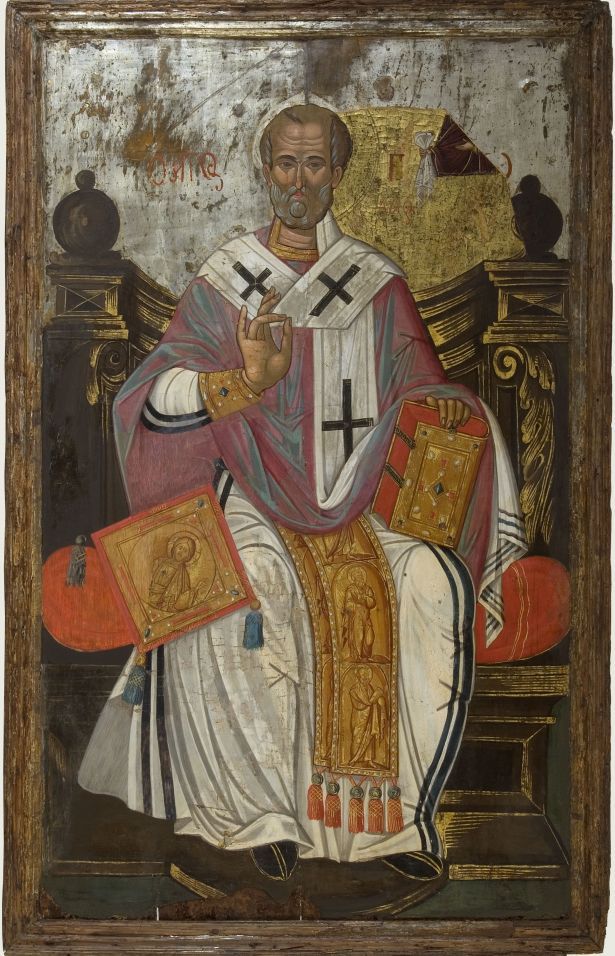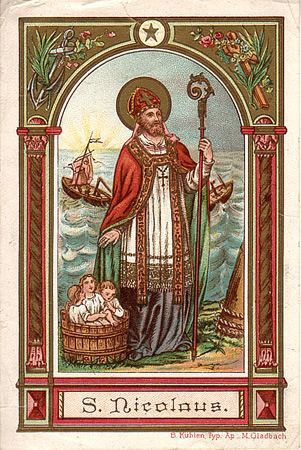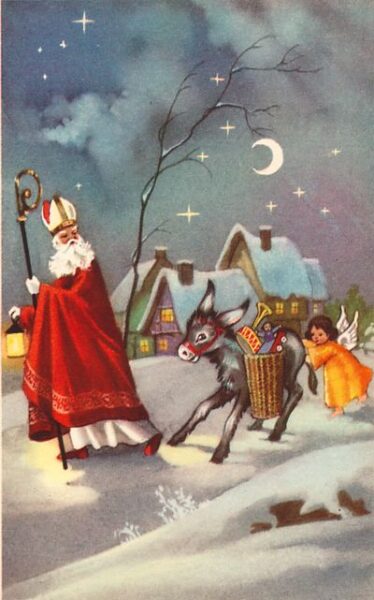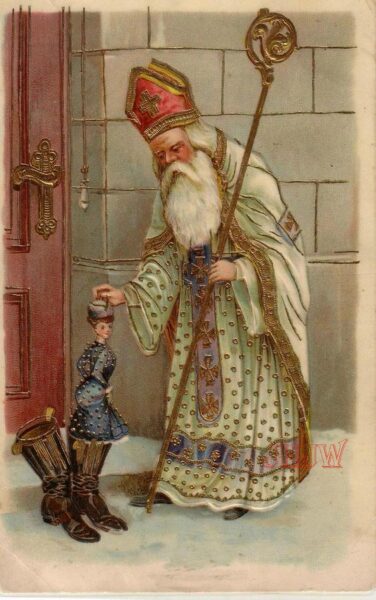
Last updated: December 5, 2024
I am always so fascinated with learning about the origins of the customs we observe and holidays we celebrate and how they evolved and became secularized, especially as they were romanticized on a large scale in the US, during the 19th-century. You can find my blog post about Saint Valentine’s Day here. And a blog post with a bit of food history related to Halloween here. And another on the origins of the New Year’s Eve tune Auld Lang Syne.
But today is the feast day of Saint Nicholas, and I am digging into the origin of our present day, secular Santa Claus. The history of Santa Claus does not go back as far as you would think, unless you consider his true historical origin to be Saint Nicholas. The commercialized Santa Claus seems to have really been born in modern form in 1823, when the poem “Twas the Night Before Christmas” was published in the Troy Sentinel newspaper in upstate New York. But not to digress, there was surely an historic Saint Nicholas, and he is surrounded by an ocean of legends and miracles.
Nikolaos of Myra (270-343 ce,) was a 4th-century saint and Greek Bishop of Myra in Lycia (on the southwest coast of present day Turkey.) He was born in the village of Patara in Asia Minor, an area with a Greek heritage, and was raised as a Christian. His parents were wealthy, but they both died in an epidemic while he was still young. Taking the teachings of Jesus seriously, Nicholas sold his inheritance and gave alms to the needy – those who were sick and/or entrenched in poverty. He dedicated his life to the church and serving God, and was ordained a priest by his uncle, who was the bishop of Patara. Nicholas was very zealous and pious and made a pilgrimage to the Holy Land, looking to more deeply experience the life, death, and resurrection of Jesus. It is said that he may have lived in a cave for three years before returning home to Myra. Sometime after he returned, the bishop who succeeded Nicholas’ uncle passed away, and so Nicholas was ordained as a bishop, perhaps around 300 ce.

Bishop Nicholas was exiled and imprisioned by the Roman Emperor Diocletian, who was persecuting Christians and demanding that he himself should be worshipped as a god. After Diocletian’s death in 311 ce, Nicholas was released, and he returned to his priestly duties as a “confessor of the faith,” a title given to Christians who were imprisoned and tortured for their faith, but not executed.
Bishop Nicholas attended the Council of Nicaea that was convened by the Emperor Constantine in 325 ce. According to legend, he punched out Arius, a church leader from Alexandria in Egypt, who had testifed that he believed that Jesus was just a prophet and not divine. See image 2 above. Bishop Nicholas was imprisioned for the fight, but that night he was visited by the Holy Family who released him from his bonds and dressed him again in his apostolic clothing. The story says that the bishops were astonished by this miracle and realized that Nicholas’ anger was righteous. He was honorably restored to his position, but it is said that he slept through much of the remaining proceedings. Despite this story, it is uncertain if he actually attended the Council of Nicaea. There are various historical lists of attendees, and he is not on every list. For example, early church historians Eusebius and Athanasius do not mention Bishop Nicholas, so it is possible that he was added to lists by later scholars who just assumed that he must have been there.

Paintings and icons of Saint Nicholas often show a scowling, hard, curmudgeonly man, seemingly unlike our modern and jolly Santa Claus. The icon of Saint Nicholas in image 1 above and to the left shows him with his face turned slightly to the viewer’s left (the “sinister” side.) This icon type is usually called Nikola Otvratnuiy (Никола Отвратный) or “Nicholas the Turner.” It is derived from Old Believers and first appeared toward the end of the 18th century. Nevertheless, Nicholas was remembered as generous and is said to have saved a number of innocent men who were facing the gallows. Saint Nicholas died in Myra in 343 ce. and his feast day is celebrated on December 6. Honored and revered in both Orthodox and Western denominations, Saint Nicholas is the patron saint of sailors, merchants, archers, children, and students. This is especially the case in various Eastern European countries – most notably in Russia. Here are a few stories about him as a wonderworker and some details about the miracles he performed.
Saint Nicholas was known for his generosity and love of children, and the oldest story about his role as a protector of children actually takes place after his death. According to the legend, the people who lived in Myra were celebrating the feast day of Saint Nicholas, when a band of Arab pirates from Crete sailed into town. They stole treasures from the Church of Saint Nicholas and kidnapped a boy named Basilios who was sold into slavery. The emir who bought Basilios used him as his personal cupbearer, and he waited on the emir, serving him wine in a beautiful golden cup. Meanwhile, his parents were devastated at the loss of their only child and filled with grief. As the next feast day of Saint Nicholas approached, Basilios’ mother would not join in the festivities, because it was now, for her, a day filled with sorrow and tragedy. Finally, she was persuaded to have a simple observance at home, where they said quiet prayers for Basilios’ safekeeping. At that moment, Basilios was suddenly whisked up and away. Saint Nicholas appeared to the terrified boy, blessed him, and sent him back down to his home. When Basilios appeared before his parents, still holding the emir’s golden cup, the joy and amazement were overflowing. Everyone rejoiced, and this is how St. Nicholas became known as the patron saint of children.

Another legend tells of three theological students, traveling on their way to study in Athens, during a time of famine. An innkeeper robbed and murdered them, hiding their bodies in a large pickling tub. Saint Nicholas, traveling along the same route, stopped at this inn. That night, he dreamed about the crime, got up, and summoned the innkeeper. As Nicholas prayed earnestly to God, the three students were restored to life and wholeness. In France, this story is told with three small children being murdered instead of older students. Saint Nicholas appears and appeals to God to return the children to life and to their families, which came to pass. You can see a depiction of the story on the image of a Saint Nicholas prayer card above to the right. This story also emphasizes Saint Nicholas as the patron saint and protector of children.
Another story associated with Saint Nicholas tells how he helped a poor man who had three daughters. Because the man did not have money or other valuables to offer to prospective husbands for his daughters, he was quite concerned. In those days, a young woman with no dowry was unlikely to marry and could even be sold into slavery or prostitution. According to the legend, a bag of gold mysteriously appeared on three separate occasions at the house of the man and his daughters. It is said that the gold was tossed through an open window and landed in the stockings or shoes left by the fire to dry. Everyone rejoiced, and this is how Saint Nicholas became known as a secret gift-giver. This is also the reason that you sometimes see netted bags of chocolate with gold coin wrappings sold in stores, like World Market, as stocking stuffers.
There are a number of legends that link Nicholas with the sea and his protection of distressed sailors. In one story, Nicholas was returning to Myra from his pilgrimage to the Holy Land, when the ship that he was on was threatened by a great storm. After Nicholas calmly prayed to God for help, the frightened sailors were amazed that the wind and waves died down, and the ship was saved from destruction. In this way, Saint Nicholas became the patron saint of sailors and pilgrims. Grateful sailors built chapels that honored him in many seaports.

Another miracle related to the sea occurred when a ship in the Mediterranean Sea became grounded in shallow waters. Based on widespread stories of Saint Nicholas protecting boats and sailors, the crew of the ship appealed to him for help. Even though they were distant from him, they believed that Saint Nicholas might be able to intercede to God for them. At that moment, Nicholas appeared on the ship and helped the sailors to retie and strengthen the ropes that were holding the masts. Together they used poles to push the ship away from the threatening rocks into deeper water. When the boat was completely freed and the crew were able to set sail, Nicholas disappeared.
In the Middle Ages, the popularity of Saint Nicholas increased greatly, and he became the patron saint of Apulia, Sicily, Lorraine, and numerous cities in Austria, Germany, Belgium, the Netherlands, and especially in Russia. Grand Prince Vladimir I of Kiev (958-1015 ce) was responsible for bringing the devotion of Saint Nicholas to his homeland. Saint Nicholas became the patron saint of Russia in 987 ce. Thousands of churches were named for Saint Nicholas across Europe, and his tomb in Myra became a popular pilgrimage site. Due to fear of violence near Myra (and for religious and economic reasons,) the Italian cities of Venice and Bari tried to obtain his relics (bones) to create an alternate pilgrimage site. In the spring of 1087, sailors from Bari were successful in stealing the relics and moved them to their seaport on the southeast coast of Italy. The shrine built there became one of the great medieval pilgrimage sites, and pilgrims, and tourists today still visit the impresive Basilica di San Nicola in Bari. That is why you can see some early Christmas postcards or prayer cards that reference “San Nicola di Bari.”
Nicholas became known as “Nikolaos the Wonderworker,” because of the miracles attributed to him and because he secretly did kind deeds and helped people who were in need. Over the centuries, a tradition evolved whereby children would leave their shoes outside, on a window sill, or on the hearth on the night before the feast day of Saint Nicholas. Children would also leave carrots out for the donkey, and in the morning would find the gifts left in their shoes. In this way, Saint Nicholas came to be the model for our modern Santa Claus, whose name comes from the Dutch name Sinterklaas.
I looked at a number of vintage St. Nicholas/Santa Claus images and picked out these two below to share with you, because they still show Saint Nicholas in his bishop’s vestments. Rather than Santa Claus with the red suit, here he still wears the bishop’s miter (hat) and carries a crozier (staff.) You can find more images, including orthodox icons on my Pinterest Section Saint Nicholas.

Surely Saint Nicholas morphed into Santa Claus over the years, but I think it’s nice to know more about the historic Saint Nicholas and the legends of his miracles.
Happy Feast Day of Saint Nicholas!!
UPDATE: This blog post was updated on December 5, 2024 to add images 2 and 3 and to make minor editorial changes.
Reference 1: Website, Saint Nicholas Center: Discovering the Truth about Santa Claus, https://www.stnicholascenter.org/.
Reference 2: Christopher Warner, You Better Watch Out – St. Nicholas is Coming to Town: The seldom-told stories of St. Nicholas the Wonderworker, blog post at Catholic World Report, December 6, 2022.
Reference 3: Charles Pope, The Real St. Nicholas – Not Fat and Not Very Jolly Either, December 5, 2012.
Reference 4: Alexandra Guzeva, “St. Nicholas, Russia’s Most Popular Saint in Icons,” blog post at Russia Beyond website, June 13, 2022.

Reference 5: David, “All About Nicholas (Well, Not Quite All,)” blogpost at Icons and their Interpretation, November 22, 2014.
Image 1: Russian icon, written by Aleska Petrov for Lipnya Church of St. Nicholas in Novgorod, circa 1294, now on exhibit at Novograd Kremlin Museum.
Image 2: Detail of a late medieval Greek Orthodox fresco showing Saint Nicholas slapping Arius at the First Council of Nicaea, Wikimedia Commons, public domain.
Image 3: Icon of Saint Nicholas, second half of the 17th century from Messina. In collection at Byzantine and Christian Museum in Athens, Greece. Accession number BXM 10817, photograph by Véronique Magnes, 2012.
Image 4: Saint Nicholas, German prayer card, circa 1850, St Nicholas Center Collection.
Image 5: Russian icon, from Lipnya Church of St. Nicholas in Novgorod, circa 1294, posted on December 6, 2012.
Image 6: Vintage Postcard from Belgium, St. Nicholas Center Collection.
Image 7: Jan Willemsen, flickr.com, CC BY-NC-SA 2.0, September 14, 2009.















Leave a Reply
Join the conversation by submitting a comment to this blog post below.